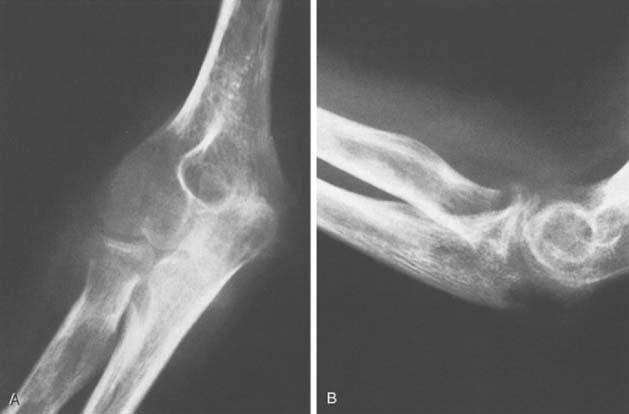CHAPTER 85 The Elbow in Metabolic Disease
INTRODUCTION
With the possible exception of tumoral calcinosis, no metabolic diseases have a special predilection for or a characteristic presentation at or about the elbow joint.1,6,19 Therefore, information is rather limited on the effects of metabolic bone disease of the elbow joint. In fact, at the Mayo Clinic, the radiographic bone survey routinely taken to assess the extent of involvement of these diseases does not include the elbow region. A MEDLINE review of all the conditions discussed herein from 1996 to 2007 revealed only one citation of any of these conditions related to the elbow.12 No attempt will be made here to mention all the conditions that might incidentally involve the elbow. However, several conditions are regularly manifested at this joint: gout, pseudogout, and inborn errors of metabolism that cause congenital anomalies (see Chapters 13 and 75). Paget’s disease may, of course, involve any part of the body, including the elbow (see Chapter 82). Synovial chondromatosis is mentioned here and in the section on arthroscopic management of loose bodies (see Chapter 38).
RICKETS
In the immature skeleton, vitamin D deficiency typically causes widening of the physis and cupping of the metaphysis, which are well represented at the wrist. Interestingly, although it has not been emphasized in the literature, rather dramatic widening of the radiohumeral joint is typical of this disease (Fig. 85-1). The deficiency will obviously be better demonstrated in the faster growing bones, and the physes of the distal humerus and proximal forearm are relatively slow growing.6 Thus, the manifestations of rickets in the region of the elbow are usually not dramatic.
OSTEOMALACIA
Classically, vitamin D deficiency of the mature skeleton resulting in the production of uncalcified osteoid may be due to one of several mechanisms—nutritional intake deficiencies, absorption abnormalities, and utilization abnormalities.15,16 Dialysis is one of the most common causes for this condition today. Radiographically, marked loss of bone density is usually observed along with coarsening of the trabecular pattern. There are no characteristic features at the elbow (Fig. 85-2). The lack of structural integrity causes bowing deformities of the weight-bearing extremities, but this is uncommon in the upper limbs.
TUMORAL CALCINOSIS
Extensive para-articular calcification, so-called tumoral calcinosis, does have a certain predilection for the elbow region, although it is more common at the hips and shoulders.7 The differential diagnosis includes hyperparathyroidism, hypervitaminosis D, calcinosis universalis, and calcinosis circumscripta.4 Tumoral calcinosis characteristically occurs in young persons who have normal serum calcium concentrations, but a predilection has been noted in black persons and a familial tendency has also been reported.7,12 First described by Inclan and colleagues in 1943,9 the association with hyperphosphatemia has suggested a metabolic cause for this disease.2,13 Chemical assessment reveals hyperphosphatemia but normal levels of serum calcium, parathyroid hormone, and alkaline phosphatase. The exact cause of the condition is obscure, but calcium salts are deposited in the posterior or anterior extra-articular regions of the elbow. The calcium salt is usually calcium phosphate or carbonate. A well-circumscribed capsule may be present around the firm to soft, discrete masses. Sinus drainage may be seen as well.12 In one report, a similar radiographic appearance was demonstrated that was attributed to the deposition of hydroxyapatite crystals.8 The intra-articular nature of this deposition serves to distinguish it from true tumoral calcinoses (Fig. 85-3). Surgical treatment can be successful, particularly if the tumor masses are relatively small. Large areas of involvement, however, often cause difficulty with wound healing, and scarring in the skin and subcutaneous tissue (see Fig. 85-3









